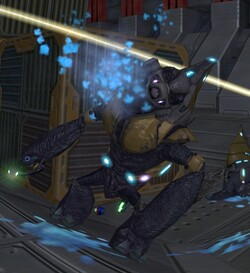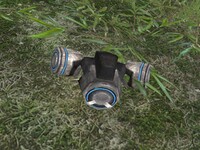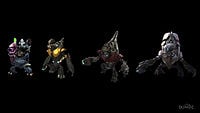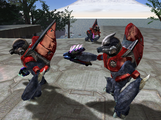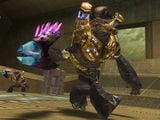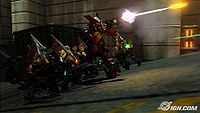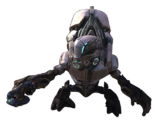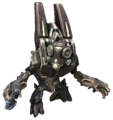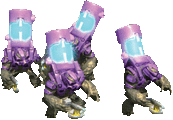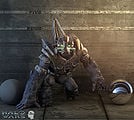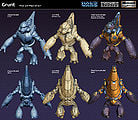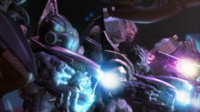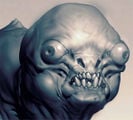Unggoy
From Halopedia, the Halo wiki
| This article does not meet the wiki's general standards and/or standards on layouts. You can help by cleaning this article. |
| This article does not have enough inline citations and/or does not adhere to the proper citation format. You can help Halopedia by adding citations. |
- "When in doubt, flee."
- — Unggoy philosophy[1]
The Unggoy[2] (Latin, Monachus frigus, meaning "cold monk") are a species of squat bipedal vertebrates, (commonly misidentified as arthropods),[3] in the unified races of the Covenant. They are the lowest-ranking species in the hierarchy, and are frequently mistreated by almost every higher-ranking race (Sangheili, Jiralhanae, Kig-Yar). Unggoy are primarily used as laborers or, in combat situations, cannon fodder. They are one of the later races to be introduced into the Covenant, and were either the second or third Covenant species to be encountered by humans. They are referred to as Grunts by humans, mainly because they are considered weak compared to their superiors and also because they perform the majority of the labor required by the Covenant.
History
The Ark and reseeding
Prior to the activation of the Halo Array, the Unggoy had managed to achieve a Tier 4 society on their homeworld, Balaho. However, the planet and the Unggoy civilization was devastated by the collapse of its biosphere due to massive global overindustrialization.[4]
The Unggoy were one of many species indexed by the Librarian for preservation on Installation 00 from the firing of the Halo Array. They were subsequently returned to their homeworld Balaho, where they began re-building their culture.
Induction into the Covenant
Grunts were the sixth client race to be integrated into the Covenant, not including San 'Shyuum and Sangheili, about 411 years before the end of the Human-Covenant War, roughly coming to their indoctrination in 2142 on the military calendar. By the time of their discovery by the Covenant, the Unggoy homeworld was still recovering from its ecological collapse over a hundred millennia earlier, and the Unggoy civilization had yet to return to its former state.[4]
While they are essentially a slave race, the Unggoy have managed to largely retain their cultural identities, and have rebelled in the past more than once. Being the lowest-ranked species of the Covenant, they are bitter rivals with the Kig-yar, who are also low-ranked. The higher-ranking races of the Covenant have often ignored this rivalry. The breaking point came when a junior staffer in the Ministry of Concert[5] discovered evidence of the Kig-yar planning to poison recreational narcotics the Unggoy enjoyed, which would have left them sterile, but the High Council refused to investigate the matter. The rising tensions with the Kig-yar and the general disinterest from the other Covenant races led to an Unggoy Rebellion in 2462. While the rebellion was ultimately put down thanks to an Arbiter and the near-glassing of the Unggoy homeworld, the Unggoy proved that they were not the cowards they had been long deemed, and could indeed be vicious fighters when provoked. After the uprising's conclusion, as was their tradition, the Sangheili forgave the surviving Unggoy and allowed them to enter the Covenant military as armed infantry units, rather than the unarmed cannon fodder as which they had previously served.[6]
Despite the low place they have in the Covenant Hierarchy, the true irony is that the Unggoy's entry into the Covenant has ensured their species' survival. Membership in the Covenant granted the Unggoy freedom from risk of extinction during Balaho's two winters, as they now have access to sufficient supplies of food. Infant mortality has decreased to below fifty percent, and geronticide is no longer a necessity for survival. The average life expectancy for non-combatant Unggoy has doubled.[7] Their incorporation into the Covenant likely also alleviated the threat of the Blue Death, which Unggoy typically fear.[8]
The Great Schism
The Unggoy obey other Covenant races out of fear more than religious faith.[9] They have next to no political power in the Covenant; the highest political rank available to an Unggoy is Deacon. Within the Unggoy community there is a strong resentment of other species, especially the Kig-yar. The low rank of the Unggoy, as well as the aforementioned war, also led to a lack of political loyalty during the Great Schism, as the Unggoy did not ally with a particular side, and stayed with whoever commanded them, most likely out of subservient fear to their current masters. However, many of those serving under the Jiralhanae still held support for the Sangheili and revered the Arbiter, pointing out to their comrades that they once served under him.
Post-war
After the Human-Covenant War, at least some of the Unggoy continued working for the Sangheili as farmers on Sanghelios, while others continued to work in the military under either their Sangheili or Jiralhanae commanders.[10] An unknown number of Unggoy eventually joined the Covenant remnant, a splinter group that upheld the Covenant's religious beliefs after the war. ONI surveys record no off-planet transport from Balaho since "Solipsis" and seem to indicate that Buwan has been abandoned, though both remain under observation. Moderate Unggoy populations have been observed in Sangheili systems at various intervals.[11]
Description
Unggoy are, in general, poor soldiers in terms of skill and combat ability. They are poor shots when not focused, are physically weak, and are tactically inept as a rule. If their commanders are eliminated during combat, they frequently panic and scatter in random directions. However, what Unggoy may lack in individual skill, they make up for with tenacity and sheer numbers. The Covenant used the high breeding rate of the Unggoy to their advantage in the Human-Covenant War, where squads of Unggoy frequently overpowered UNSC personnel through force of numbers. A group of renegade Kig-Yar on the moon Metisette also took advantage of the Unggoy's prodigious reproductive rate, breeding an army with which they hoped to invade Earth.
Unggoy are the only Covenant species to breathe methane rather than oxygen. Their combat armor/harness has an integrated methane re-breather system, as Unggoy are unable to survive for long periods of time without methane due to asphyxiation. Due to this, if the player manages to melee their methane tank off, they rapidly suffocate and die.
Psychology and behavior
While not overly intelligent or creative on the battlefield, Unggoy are one of the most gregarious and sociable of the Covenant races and possess a very strong pack mentality, often associating with each other in groups. This numerical superiority and pack mentality allows for their sense of cultural identity to remain, despite a number of hardships, including their extreme subservience to the other races of the Covenant, as well as the dark time following reintroduction after the activation of the Halo Array.[4]
Although they are quite capable of handling weaponry and operating vehicles and machinery such as Ghosts and Shades, Unggoy are generally rather simple-minded. There are exceptions to this rule, however: the Unggoy Deacon Dadab, for example, was noted as being quite intelligent for an Unggoy, as demonstrated by his ability to learn and communicate in Huragok sign language. An inherent psychological advantage possessed by the Unggoy are their unburdened neural pathways, which allows Unggoy to absorb knowledge more freely compared to the other Covenant species. As such, they are often tasked with monitoring space for traces of human communication. In addition, many Unggoy have developed a clear understanding of two or even three human languages. This advantage serves as a river of confidence in times of great stress for them.[4]
Unggoy generally follow a few short, simple guidelines given to them by the Sangheili; for example, "When in doubt, shoot" or "Stay out of the way, live another day." Despite being held in low regard by the Covenant, many Unggoy appear to be strong followers of the Great Journey. Their Deacons will often hold sermons onboard ships to boost the morale and teach the Unggoy onboard about the Covenant. For instance, a Deacon named Dadab gave sermons and taught the Unggoy on board a Jiralhanae cruiser about the Covenant and its religions. The Jiralhanae allowed Dadab these teachings because they believed that it would help the Unggoy become more competent and helpful.
Unggoy often gamble with each other and often play games; one in particular, hunting rock, involves two Unggoy competing to kill the most scrub grubs.
Unggoy were also known to take recreational narcotics called Infusions by adding them to their portable methane tanks.[12][13]
Anatomy and physiology
The taxonomic classification of the Unggoy has been a source of some confusion for the UNSC. Because they possess exoskeletons, they have been identified as being analogous to Earth arthropods; despite this, the Unggoy are actually a vertebrate species. The United Nations Space Command misclassified the species as arthropodal due to its overall resemblance and similar evolutionary structure to terrestrial arthropods; among other differences, their circulatory system is much more vertebrate than arthropod in nature.[3] More accurately, the species should be considered xeno-arthropodal vertebrates which possess substantial, (albeit hypothetical), genetic influences from primate-like amphibians that once dwelled in Balaho's aphotic zones. This taxonomically incorrect nomenclature persists as late as 2557 as an ad hoc identifier, though the pressures of the Human-Covenant War and reconstruction have made such concerns trivial at best.[3]
Unggoy share a number of features with different animal species on Earth. Like primates, they walk both bipedally and with the aid of their oversized forearms. However, their bodies are armored with a hard exoskeleton as with crabs and insects. Their mouths have a set of small, pointed teeth, much like reptiles. Unggoy are on average about four to five feet tall and are relatively weak compared to other Covenant species. Although they can easily walk upright on two legs, they may often use their arms to move in a quadrupedal fashion. While carrying armaments, they are forced to walk upright so that they may support their weapons with their hands, but while trying to flee, or while patrolling without a weapon drawn, they use their over sized arms as forelegs to add speed or stability to their gait. Their eyesight[3] and hearing are average, and seem to have a very well developed sense of smell, sometimes sniffing the air to detect traces of foes or hidden enemies.[14] This is facilitated through the olfactory membranes installed in their masks.
Unggoy also have thick, bio-luminescent,[15] light-blue blood,[16] possibly a result of methane-based proteins in the blood to facilitate methane-based respiration. Like Earth's Horseshoe Crabs, it is possible that their blood is blue due to high copper content.
Unggoy have over-sized forearms, while their upper arms and thighs are seemingly small. This has allowed them to be quite excellent climbers. Spiny protrusions on their elbows help them scale rocky surfaces and may also be used to add force to their melee attacks. They also have an astonishingly fast finger reflex speed, as they can fire a plasma pistol at almost the same rate a Sangheili can with a plasma rifle.
The Unggoy have flat, three-toed feet, with another toe on the back of their feet. While they are small, stocky, and lacking in agility, they are quite sturdy; most may be weak, as they seem to be unable to carry a weapon heavier than a plasma pistol, although certain Unggoy of higher ranks appear to be surprisingly strong, able to carry an undeployed plasma cannon or fire a fuel rod gun with one hand without toppling from the recoil. However, physical strength may not actually go along with rank; the types of weapons available to them may be a part of a "trust" issue with the other Covenant. As rank-and-file Unggoy are clumsy and tactically inept, more powerful weapons are likely only issued to those who are more disciplined and experienced.
Although they require an atmosphere to breathe, Unggoy are capable of surviving in the vacuum of space without sealed, full-body gear. Unggoy carapaces apparently can withstand the chilling cold and airless environment of EVA conditions, but they must employ sealed face masks in order to breathe, as well as presumably to protect their facial tissues. This tolerance of vacuum is apparently not shared by the less-armored Unggoy subtype encountered in the post-war years, as they require full-body gear to survive in a vacuum.
Subtypes
Some Unggoy, commonly seen among bands of Covenant remnant forces in the mid 2550s, have exoskeletons that cover only patches on their bodies, leaving most of their skin exposed; the paucity of chitin means that the elbow and knee spikes of these individuals are less pronounced.[3] Unlike other Unggoy, which have a chitinous protrusion that covers the groin and posterior, these Unggoy are unarmored in this area, exposing their primate-like buttocks.[17] Their necks are also several times longer than normal, (Unggoy typically have almost nonexistent necks), and their heads are set farther forward; folds of loose skin hang down from their necks and chins, likely due to the relative lack of chitin. Their eyes are reddish orange and feature black, cross-shaped pupils, unlike the solid red or yellow eyes of their kin. Their mouths are set farther inward and house larger, more pointed teeth. These specimens have much stouter legs and have longer and thinner fingernails than the rest of the species, and they possess claws on their feet instead of the more common hoof-like digits. It is unclear what sets these Unggoy apart, (morphologically speaking), from the rest of their kind, though it has been theorized that they belong to a different species, that they are the result of natural mutation, or that they came about due to selective breeding and genetic experimentation; in any case, such morphological variation can be likened to the differences among dog breeds.[3]
Reproduction
Unggoy breed prodigiously, with large egg clutches and short childhood periods.[4] This combined with the large number of young per clutch and rapid sensory-motor integration development was one of the primary reasons why the Covenant cleverly used the breeding habits of the Unggoy to their advantage in battle, deploying the Unggoy as cannon fodder (this would play a key-role in their war against humanity). Overpopulation is a serious problem and in non-war times, strict laws are placed on Unggoy breeding.
Unggoy do value their ties to their offspring, but are usually separated from their families at an early age by the requirements of military service to the Covenant. They resent this greatly, but because of their low social status in the Covenant, they are unable to muster any response.
Culture
The Unggoy culture has been largely wiped out as a result of constant indoctrination by the Covenant, they do retain a degree of their cultural identity as a result of their inherent tenacity. Of what is known, the Unggoy generally live in small, tribal societies which are typically defined as being matriarchal.[4]
Naming
Unggoy often have names which reflect a language of very simple phonics. Common names, such as Yayap and Dadab, begins with a reduplicated consonant and consist of two syllables. Other names typically consist of a single syllable with clusters of consonants, such as "Flim". Some exceptions have occurred of which a name has more consonants than is usual while following the first method of naming, as in Kwassass. Often, their names are palindromes, such as Zawaz.
Unggoy names encountered so far consist of these phonemes:
- The vowels short A and short I.
- The consonants D, F, K, L, M, S, W, P, Y and Z.
Unggoy do not have family names, possibly because the Sangheili did not allow it. Instead, they identify themselves by famous ancestors, their homeworld, and where on that planet they lived.
Homeworld
- Main article: Balaho
The Unggoy homeworld of Balaho is a temperate, swampy planet with a methane atmosphere and naturally occurring pillars of fire. The cold season of their planet makes them highly covet any source of warmth and light they can find, mainly due to the "Blue Death".[8] The planet is still in process of recovery from a global ecological collapse before the activation of the Halo Array due to overindustrialization caused by the Unggoy at the time.[4]
Since their natural environment has a methane atmosphere, they would need to carry methane tanks and breathing apparatus with them whenever they travel into areas without high levels of methane in the air. Since all the other races of the Covenant, and their human enemies, breathe oxygen, the Unggoy find themselves wearing breathing masks more often than not.[18] They have been revealed to be inhabiting large environment domes that have airlocks and methane filters for them to breathe, while not in armor[19] or restocking their methane reserves at battlefield methane tanks. They seem to have high-pitched and squeaky voices, possibly due to the different resonating properties of methane gas. The high-pitched voices are commonly regarded as humorous by most other races, since they tend to sound like frightened children trying to sound intimidating.
Food
The unggoy planet was home to swamp sickle a very small creature who could only stand a swamp temperature with only one eye their depth perception was easy for the unggoy to catch these 'swamp sickles"these little creatures were supposed to be approx 10 centimeters. They would die as soon as they hit the methane gas.What they used for catching these sickles were a stick with a pointy rock at or simply with their hands. they used their hand or simply "spears" until the prophet's came to their world they just used tools to catch their fish.
Gameplay
- Main article: Unggoy/Gameplay
Overall, the Unggoy in gameplay are very weak in combat; often fleeing when their leader has been killed. However, in larger numbers, they can be more of a threat, especially in higher difficulties. If their leader is killed, Unggoy may sometimes activate two plasma grenades and rush to the player in an attempt to suicide-bomb them.
In Halo Wars, the Unggoy serves as the main infantry unit, serving as the Covenant equivalent to the Marine. They start with a plasma pistol and three in each squad, but they can be upgraded to wield needlers.
A melee attack can kill a Grunt instantly, so when you face no more than 5 of them, don't waste your ammo and just punch them. For large groups use the Gravity Hammer, unless the catch skull is on meaning you have to stay outside their range, as even in close-range the Grunts will not hesitate to spam-grenades at the enemy.
Trivia

|
See our gameplay information related to Unggoy on its gameplay page. |

|
Check out our collection of quotes related to Unggoy on its quotes page. |
- In Tagalog, Unggoy means "monkey".
- In real life, "Grunt" is a slang military term for infantrymen.[20]
- Unggoy enjoy trading human communication files, such as soap operas and comedies, through the black market.[21]
- The Unggoy were ranked #5 in Game Informer's "The Top 10 Most Pathetic Enemies" list.[22]
- In Halo: Reach, Unggoy voices were changed. Instead of their original high-pitched and squeaky voices, they sound more deep and mechanical, possibly because of their breathing apparatus. However, they are still being voiced by Joseph Staten.[23]
- In Halo: Reach, if an Unggoy's methane tank is shot or meleed it may fall off, causing the gas to launch said Unggoy into the air and eventually explode. Many players consider this a great hazard, especially on higher difficulties.
- The redesigned Unggoy that appear in Halo 4 bear a great deal of resemblance to the wretches from the Gears of War series.
Gallery
- Unggoy concept.jpg
Early concept art for Halo: Combat Evolved
- Grunt Concept.jpg
Early concept art of an Unggoy Flood combat form.
A cylindrical-Backed Unggoy as seen in The Last Voyage of the Infinite Succor.
- 1 grunt.jpg
An Unggoy as depicted in Halo 3.
- Grunt-turret.jpg
An Unggoy Minor firing a plasma turret on board a Scarab.
A Brute Captain leads a pack of Unggoy in the Earth Bunker Crow's Nest.
List of appearances
Sources
- ^ Halo Encyclopedia: page 144
- ^ Halo: Ghosts of Onyx, page 191 - "Unggoy: the Elite name for the Grunt race."
- ^ a b c d e f The Halo Bulletin - 5.9.12
- ^ a b c d e f g Bestiarum
- ^ Halo: Contact Harvest, page 150
- ^ Halo Encyclopedia, pages 142, 153
- ^ Halo Encyclopedia, page 143
- ^ a b Halo: Ghosts of Onyx, page 237
- ^ Halo 3, Sierra 117 - Arbiter: "The Grunts' newfound courage is but fear."
- ^ Halo: Glasslands page 90
- ^ Codename: SURGEON's post-war analysis
- ^ Halo: Contact Harvest, pages 150-151
- ^ Halo: The Thursday War, pages 186 and 187
- ^ Halo 2, campaign level The Arbiter
- ^ Halo: First Strike, page 59: Phosphorescent blood pooled beneath their prone forms.
- ^ Halo: The Flood, page 27
- ^ McFarlane Toys - Halo 4 Storm Grunt
- ^ Halo: The Flood
- ^ Halo: The Flood, page 60
- ^ Grunt on Wikipedia
- ^ Halo Encyclopedia, page 143
- ^ GameInformer: Top five video game punching bags.
- ^ Bungie.net : Bungie Weekly Update 4.16.10

